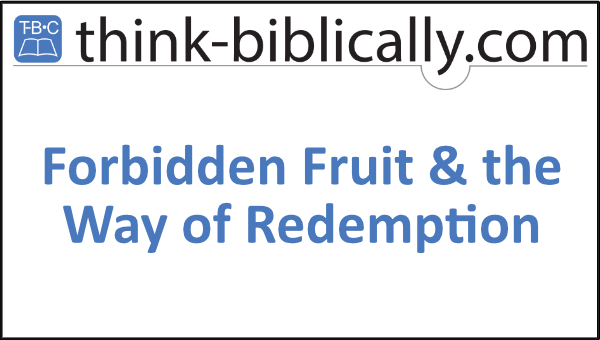By Tyson Thorne

Everyone knows the story, even those who do not know the Bible. Adam and Eve and the fall of humanity into sinful rebellion. It’s so familiar that one of the most profitable companies in the world (after their 2022 earning report the company is valued at $3 trillion dollars) uses imagery from the story for their corporate logo. I’m talking about Apple, of course, and their logo of an apple with one bite taken from it. Centuries of Western European tradition identify the forbidden fruit as an apple, but was it really? Could it have been something else?
The Bible never discloses what fruit was forbidden. That doesn’t mean we can’t make a good guess, however. First, we should remove the notion that it was in fact an apple. Apples were not introduced into the region until much later. That is not to say that an apple tree could not have been a part of the garden, but where did we derive this notion of an apple to begin with?
To answer that we step back to the end of the fourth century AD. At that time Jerome of Stridon (~340-420 AD) was put in charge of translating the Gospel’s into Latin. Enchanted by the work, he took on a great deal more and thanks to his efforts the Latin Vulgate was written, a Latin translation of the entire Bible. He worked from previous Latin translations of some texts, as well as some original language documents to create a reliable translation, one with real exegetical value. No work is completely perfect, however. In Genesis 3 he translated the Hebrew word for “bad” as “malum”, which means “apple”. History was made.
If an apple is unlikely, then what was the forbidden fruit? Jewish sources provide a variety of options, including a citron, fig, grape, nut or even wheat – yep, botanically wheat is classified as a fruit. Jewish tradition has an interesting take. A fig tree is the first type of tree mentioned in the Bible (Genesis3.7). Do you know the reference? It’s leaves are what Adam and Eve fashioned into clothing to cover their nakedness. The best guess of Jewish scholars is the fig.
Does it seem too on-the-nose that they would make coverings for themselves from the tree the forbidden fruit came from? Perhaps, but there is something poetic about it. One thing is certain, a fig doesn’t make for a good company logo.
Perhaps here is a good place to discuss the immediate effects of this most ignoble event in human history. After the fall, Adam and Eve had a son. Their first born they named Cain, a Hebrew word meaning “acquired”. After Cain killed Able, Eve had another son she named Seth, meaning “to provide”. This reveals a deep shift in Eve’s thinking about human salvation. In the first instance, the meaning of Cain may indicate that Eve thought redemption was a two-part invention; she had to do something to attain God’s forgiveness. She thought she had acquired Cain from God so she could fix the problem of sin.
This view was far from the truth, a lesson she learned from Able’s blood. By the time Seth was born she understood that the solution wasn’t hers to provide, but the Lord’s. It would be God’s actions and grace, not hers, that would bring redemption. Even in the dark days of Genesis chapters three and four there is evidence of light, grace and a plan for salvation. Such a mess, all made from the fatal decision to eat forbidden fruit.
|
|
